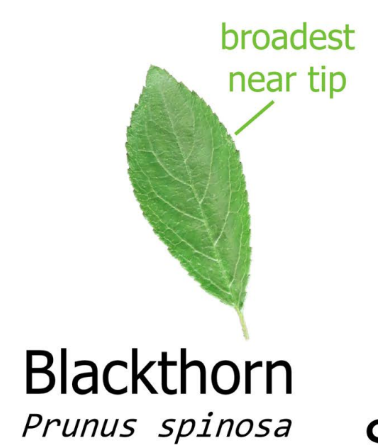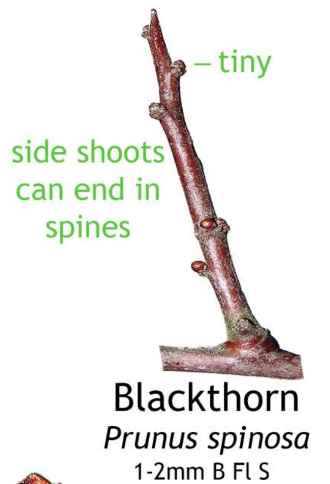A native deciduous shrub or small tree species in Ireland, often found in hedgerows, woodlands, and scrubland.
Recognising the Blackthorn Tree:
-
Leaves: The leaves of the Blackthorn are small, oval-shaped, and toothed along the margins. They are dark green in color and have a glossy appearance. The leaves emerge early in spring and turn yellow before falling in autumn.
-
Bark: The bark of the Blackthorn is dark grey to blackish and develops rough, fissured ridges with age. It provides a stark contrast to the white flowers that bloom in early spring.
-
Flowers: Blackthorn trees produce beautiful white flowers in early spring, typically before the leaves emerge. The flowers have five petals and appear in clusters along the branches.
-
Thorns: As the name suggests, Blackthorn trees are characterised by long, sharp thorns that grow along the branches. These thorns serve as a defence mechanism against browsing animals.
-
Fruit: After flowering, Blackthorn trees produce small, round fruits known as sloes. Sloes are dark blue to black in colour and have a tart, astringent flavour. They are often used in culinary applications and for making sloe gin.


5 Interesting Facts about the Blackthorn Tree:
-
Cultural Significance: In Celtic mythology, the Blackthorn tree is associated with protection, purification, and the spirit world. It has been used in various rituals and ceremonies throughout history.
-
Wildlife Habitat: Blackthorn trees provide habitat and food for a variety of wildlife species. Birds, such as thrushes and blackbirds, feed on the fruits (sloes), while insects pollinate the flowers and feed on the foliage.
-
Traditional Uses: Blackthorn wood is hard, dense, and durable, making it suitable for making tool handles, walking sticks, and traditional weapons such as cudgels and shillelaghs. The thorns were also used historically for sewing needles and pins.
-
Medicinal Properties: Various parts of the Blackthorn tree, including the bark and leaves, have been used in traditional medicine for their astringent, diuretic, and anti-inflammatory properties. However, caution should be exercised as some parts of the plant may be toxic in large quantities.
-
Hedgerow Planting: Blackthorn trees are commonly planted in hedgerows for boundary marking, livestock management, and wildlife habitat. Their dense, thorny growth provides effective barriers and nesting sites for birds.
Uses of the Blackthorn Tree:
-
Culinary Uses: The fruits of the Blackthorn tree, known as sloes, are often used in culinary applications. They can be used to make jams, jellies, pies, and alcoholic beverages such as sloe gin and sloe wine. Sloe gin is particularly popular and is made by steeping sloes in gin with sugar.
-
Woodcraft: Blackthorn wood is valued for its hardness and durability, making it suitable for various woodcraft projects. It is often used for making traditional walking sticks, hiking staffs, and tool handles due to its strength and attractive grain pattern.
-
Wildlife Habitat: Blackthorn trees contribute to biodiversity by providing habitat and food for a variety of wildlife species. The dense foliage, thorny branches, and sloe fruits support a diverse range of birds, insects, and mammals, enhancing the ecological value of hedgerows and woodlands where Blackthorn trees are present.
Contribution to Biodiversity:
-
Habitat Provider: Blackthorn trees create diverse micro habitats that support a wide range of plant and animal species. Their presence enhances habitat complexity and provides food, shelter, and nesting sites for wildlife, contributing to overall biodiversity in hedgerows and woodlands.
-
Pollinator Support: The early spring flowers of Blackthorn trees provide an important nectar and pollen source for early-emerging pollinators such as bees, butterflies, and hoverflies. This supports pollinator populations and contributes to the health of ecosystems.
-
Food Source: The fruits (sloes) of Blackthorn trees are an important food source for birds, particularly during the autumn and winter months when other food may be scarce. Birds such as thrushes and blackbirds feed on the fruits, helping to disperse the seeds and promote the regeneration of Blackthorn trees.
In summary, the Blackthorn tree is recognisable by its dark bark, white flowers, sharp thorns, and small, tart fruits (sloes). It holds cultural significance, provides valuable resources for traditional crafts and culinary uses, and contributes to biodiversity and ecosystem health in Ireland's hedgerows and woodlands. Additionally, it serves as an important habitat and food source for a variety of wildlife species.
Images taken from the beautiful posters created by Phil Barnett and you can download these and/or purchase other great designs from his online shop.
